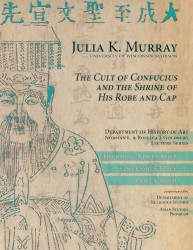
Julia K. Murray, professor of art history at the University of Wisconsin, Madison, will lecture on “The Cult of Confucius and the Shrine of His Robe and Cap” Nov. 8 in Vanderbilt University’s Cohen Hall, Room 203.
Murray’s talk, a Goldberg Lecture in Art History, will begin at 4:10 p.m.
Confucius, a major symbol of Chinese civilization, is known throughout the world as an ancient philosopher, statesman and teacher. However, many are less familiar with his role in a religious cult supported over the centuries by Chinese emperors, officials and scholars. After his death, a memorial shrine to Confucius in his hometown of Qufu, Shandong, gradually evolved into a large and magnificent temple. From the seventh century onward, schools throughout China also had temples for official worship.
Murray will discuss a shrine on the outskirts of Shanghai whose 17th-century patrons claimed that it marked the place where Confucius’ robe and cap had been buried a thousand years after his death. Using these unseen relics as a pretext, they built a ritual complex called Kongzhai, where scholarly pilgrims could offer sacrifices to the ancient sage and experience his beneficent presence.
Like many sites associated with Confucius, Kongzhai was destroyed during the Cultural  Revolution (1966-1976), but unlike most others, it has not been rebuilt. Murray will explore several ways that material forms of Chinese religious expression shaped Kongzhai’s architectural and artistic features and consider the prospects for its revival.
Revolution (1966-1976), but unlike most others, it has not been rebuilt. Murray will explore several ways that material forms of Chinese religious expression shaped Kongzhai’s architectural and artistic features and consider the prospects for its revival.
Murray has held several research and curatorial positions in art museums with major East Asian collections, including the Metropolitan Museum of Art, Freer Gallery and Harvard University Museum.
She has written numerous scholarly articles, monographs and exhibition catalogs, including Confucius: His Life and Legacy in Art (with Wensheng Lu, 2010), Mirror of Morality: Chinese Narrative Illustration and Confucian Ideology (2007), Ma Hezhi and the Illustration of the Book of Odes (1993), and Last of the Mandarins: Chinese Calligraphy and Painting from the F.Y. Chang Collection (1987).
The talk, part of the Norman L. and Roselea J. Goldberg Lecture Series, is co-sponsored by the departments of History of Art, Religious Studies and Asian Studies. For more information, contact Anne Hill at 615-322-2831.